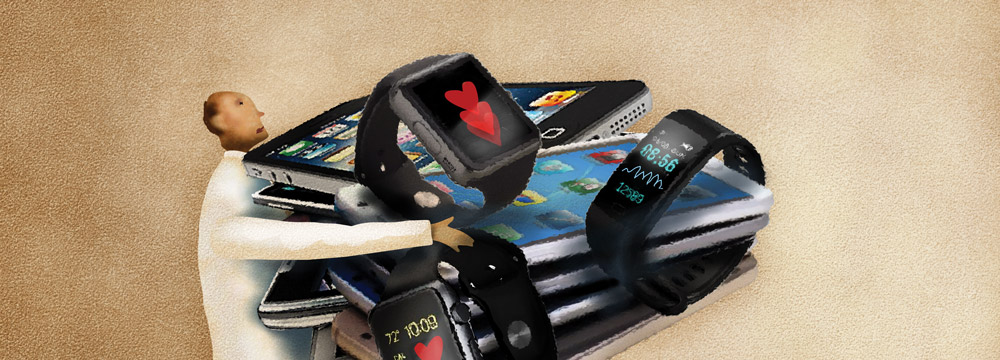
Big data and the bog of information
Key questions exist to adopting consumer-grade medical devices, such as how to analyze vast quantities of data in a meaningful way.
The young boy landed in the office of Alisa Niksch, MD, in part because of his obsession with a ninja warrior show and because he liked wearing his mother's smartwatch.
The boy constructed his own competitive obstacle course with the family's living room furniture, and at some point, as he raced through it, the watch signaled a heart rate of about 160 beats per minute. That reading—a normal heart rate for an active child—led to a cascade starting with a call to the child's pediatrician, followed by a referral to Dr. Niksch, a Boston pediatric cardiologist. The result, she noted, was an unnecessary and costly subspecialty visit.
“The child looked fine. He had zero complaints. It was just a number,” said Dr. Niksch, director of pediatric electrophysiology and the exercise stress lab at Tufts Medical Center in Boston.
In other cases, though, recreational devices can provide the first alert to an undiagnosed condition, said David Slotwiner, MD, chief of the division of cardiology at New York-Presbyterian Queens. He described patients who suddenly felt their hearts race and checked them with the device, as well as others who were feeling fine when the device registered a rate approaching 180 beats per minute. “I've had a few patients just this past year and it always turns out to be something real,” he said. “It's always a real arrhythmia.”
These are just two anecdotes, but they illustrate both the potential promise and perils of the health data revolution that's already reached the doorstep of physician offices. Though such data were once confined to prescribed monitoring devices, such as loop recorders or continuous glucose monitors, patients now carry with them a growing array of over-the-counter devices that capture everything from their smallest movements to their heart rhythms.
Researchers are already exploring whether these devices can assist with earlier detection. In late 2017, Stanford University researchers, in collaboration with Apple, announced the launch of the Apple Heart Study, which hopes to enroll up to 500,000 participants. Its goal: to see if heart rate data collected by the Apple Watch can be analyzed to detect atrial fibrillation and other worrisome heart rhythms in individuals without symptoms. More recently, an industry-funded study published July 10, 2018, in JAMA found that monitoring individuals at high risk of atrial fibrillation with an FDA-approved wearable electrocardiogram patch resulted in 6.3% of the participants being diagnosed with atrial fibrillation in the first year versus 2.3% of those getting usual care.
But even enthusiasts for more routine monitoring and analysis of patient data acknowledge that key questions remain, including how to best summarize and act on all of this incoming information.
To be helpful for patients and time-pressed physicians, the sometimes vast quantities of data will have to be synthesized and reported in a meaningful way, said Mintu Turakhia, MD, a cardiac electrophysiologist who directs the Center for Digital Health at Stanford University. But Dr. Turakhia, also a co-principal investigator on the Apple Heart Study, said there is no question that the data dynamic will alter and hopefully improve the doctor-patient relationship.
“I think what it does do is, if anything, puts patients more in control of their data and allows them to partner with their doctors for synthesis, which is really the important thing,” he said.
Collecting data and access
Most of today's patients already carry mini-computers in their pockets, with vast storage capacities. By 2018, 77% of Americans reported owning a smartphone compared with 51% just five years earlier, according to Pew Research Center survey data. Hospital and health systems also are beginning large data-related projects. This spring, leaders at Pennsylvania-based Geisinger announced that after an initial pilot phase, clinicians there would start routinely offering genetic sequencing to look for mutations linked with a higher risk of some cancers, heart arrhythmias, and other conditions.
But the extent to which simply collecting more data can actually improve weight, metabolic syndrome, and other medical risk factors, particularly where recreational wearable devices are concerned, is still being sorted out. A review article, published in 2017 in npj Digital Medicine, found only 16 high-quality randomized studies that assessed the clinical impact of wearable biosensors. The related meta-analysis didn't find any statistically significant effect on a handful of clinical outcomes, including body mass index, weight, body fat percentage, and blood pressure. But there are challenges to studying such devices, the researchers pointed out, such as effectively “blinding” patients to whether or not their own device was generating data.
While patients can easily check out their own results on smartwatches and other recreational devices, that's not necessarily true for more sophisticated medical-grade equipment. Ira Nash, MD, FACP, learned that firsthand when he had a loop recorder implanted last year to watch out for any worrisome heart rhythms related to his cardiomyopathy. (Dr. Nash hadn't experienced any symptoms but had become concerned after a study showed that patients similar to him were still vulnerable to a potentially fatal rhythm.)
Shortly after the loop recorder was implanted, the cardiologist was startled to learn that patients couldn't see their own data, which were stored with the manufacturer and shared only with the treating physician. “It would be like hiding somebody's cholesterol level from themselves, or hiding their blood pressure,” said Dr. Nash, senior vice president and executive director of Northwell Health Physician Partners in Manhasset, N.Y.
Dr. Nash, who did eventually access his own readings through channels available to him as a physician, shared his frustrations in an opinion piece published Jan. 2, 2018, in Circulation. This situation has developed in part, he said, because the device manufacturers view their primary customer as the doctor rather than the patient.
And some doctors worry about false alarms and other ripple effects of providing patient access, he said, “that it's going to lead to a lot of panic and misunderstandings and millions of phone calls to doctors' offices about stuff that's really not important, which I find a very kind of paternalistic and not very compelling argument.”
At this point, the heart monitoring data produced by these devices, which also include pacemaker and defibrillator technology, likely wouldn't be meaningful to anyone besides a heart specialist, Dr. Nash said. But indications are that at least some manufacturers are looking at how to share that data once they develop a more consumer-friendly format, according to Dr. Slotwiner.
Dr. Slotwiner, a board member of the Heart Rhythm Society, is part of a working group there that's developing guidance on how best to share data with patients from cardiac implantable and remote monitoring devices as well as personal biometric sensors. Their goal is to release the guidance document at the society's annual Scientific Sessions in spring 2019.
In his own practice, Dr. Slotwiner has noticed a slight uptick in patients asking to see their heart rhythm data. His office sends out summary reports to patients once they're received from the device manufacturer, every one to three months depending upon the device involved, he said.
As more patients carry practically their entire nonmedical lives on their smartphones, it will also make sense for them to store health data there as well, Dr. Slotwiner said. “It's almost a portal that travels with the patient that the patient shows to the doctor,” he said. “I think it will empower patients and make them more interested in being involved in their care.”
False alarms and education
Some monitoring devices already make a good effort at filtering data, only alerting a clinician or family caregiver when a worrisome pattern appears, such as a continuous glucose monitoring system sounding an alarm for hypoglycemia in the middle of the night to alert the caregiver, Dr. Niksch said.
But with some devices, and related apps, the parsing of an incoming stream of vital signs and other data can become a daunting task for physicians, she said. “Obviously with so much data the risk is that you miss something because you're just overwhelmed with information,” she said. “The data overload problem is real.”
As this technology advances, there's also the potential that, in some instances, the ability to collect information will advance faster than the clinical evidence regarding what precisely to do with it, Dr. Turakhia said. It's been argued that routine screening of symptomless individuals for atrial fibrillation will turn up other potential issues that might trigger additional and sometimes unnecessary testing. “And that's a fair point,” he said.
Moreover, Dr. Turakhia added, “we don't have a ton of great data on what to do in certain situations with newly identified arrhythmias.” That puts the primary care doctor in a tough spot when the patient comes in with potential heart issues that have been flagged by a smartwatch or some other wearable device, he said. “They didn't really ask for it, they didn't look for it, they didn't prescribe it,” he said. “Now they're stuck with having to deal with it.”
The solution, though, isn't to ignore the information already being collected by these devices, Dr. Turakhia said. Instead, he said the findings should be tapped and analyzed to improve treatment and clinical guidelines.
Not everyone is so sanguine. A criticism on the health news website HealthNewsReview.org, looking at media coverage of the JAMA atrial fibrillation patch study, quoted several doctors concerned that more identification of what they described as low-burden atrial fibrillation episodes might spur unnecessary testing without improving stroke rates and other clinical outcomes.
But in some cases, more routine screening across large populations might catch medical vulnerabilities that might not have ever been identified otherwise, said Marc S. Williams, MD, who directs Geisinger's Genomic Medicine Institute in Danville, Pa.
Geisinger, which will soon pilot offering routine genetic sequencing to its patients, has been doing so through a research project since 2014. By July, roughly 211,000 participants had agreed to the sequencing, which focuses on more than three dozen genes considered clinically actionable. The sequencing has identified at least one genetic variant in 717 of those individuals, placing them at heightened risk for various diseases and disorders, including Lynch syndrome, cardiomyopathy, Marfan syndrome, and familial hypercholesterolemia.
Roughly 40% of those who tested positive for a BRCA1 or BRCA2 mutation wouldn't have been otherwise screened as they didn't meet criteria based on personal or family cancer history, Dr. Williams said. “Our clinical criteria are not sensitive enough,” he said. Moreover, of the roughly 60% of participants who did meet criteria, about half don't appear to have ever been previously offered the genetic test based on medical records, he said.
The ongoing research project, which Dr. Williams and colleagues described in a May 2018 Health Affairs piece, also has yielded other insights. Geisinger's typical practice is to make findings like lab results immediately available to the patient in the electronic medical record, Dr. Williams said. But in the case of genetics, patients reported that they wanted the sequencing results to be shared first with their family doctor so they would have the opportunity to digest any positive mutation findings.
For his part, Dr. Nash has found the heart rhythm data generated by his own loop recorder to be reassuring, with nothing worrisome detected. Most patients might not want to see or might even be unsettled by their own heart data, he said. “That's fine. I'm not advocating that we force anybody to be his or her own cardiologist.”
But those patients who are interested might gain a window into some of their own vulnerabilities, Dr. Nash said. For instance, they might start noticing more arrhythmias when they drink too much or their sleep is dismal, he said. “I think there is a whole world of improved self-management that we are kind of leaving on the table by cutting patients out of the loop here.”



